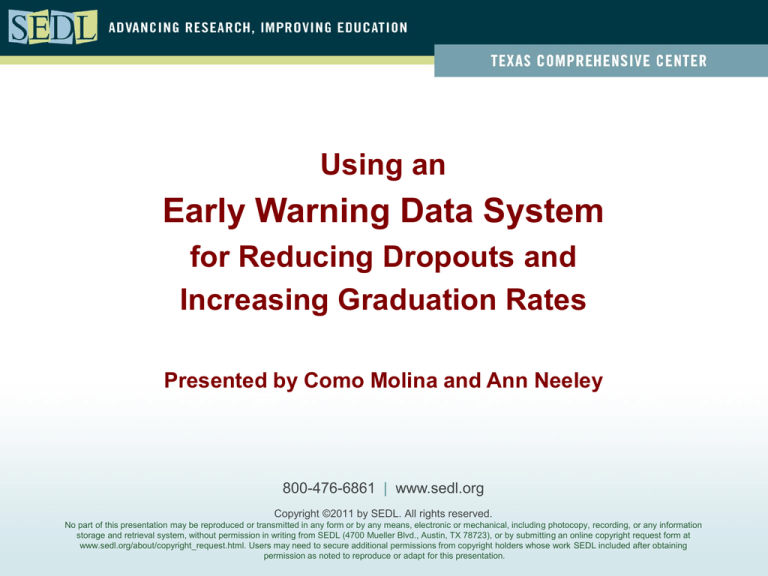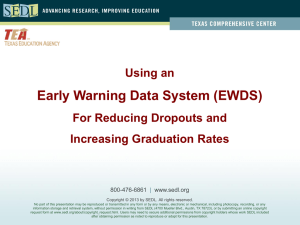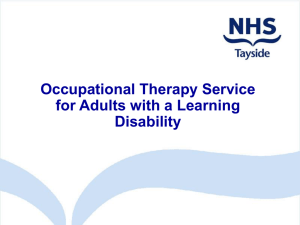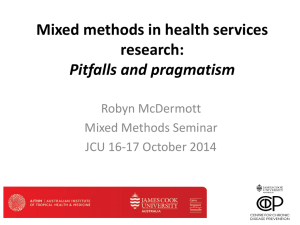
Using an
Early Warning Data System
for Reducing Dropouts and
Increasing Graduation Rates
Presented by Como Molina and Ann Neeley
800-476-6861 | www.sedl.org
Copyright ©2011 by SEDL. All rights reserved.
No part of this presentation may be reproduced or transmitted in any form or by any means, electronic or mechanical, including photocopy, recording, or any information
storage and retrieval system, without permission in writing from SEDL (4700 Mueller Blvd., Austin, TX 78723), or by submitting an online copyright request form at
www.sedl.org/about/copyright_request.html. Users may need to secure additional permissions from copyright holders whose work SEDL included after obtaining
permission as noted to reproduce or adapt for this presentation.
Objectives
Participants will
• become familiar with the Early Warning Data System
(EWDS) tool designed to help Texas districts and
schools identify students who are at risk of dropping
out and
• become familiar with the systemic implementation
required for interventions to reduce dropout rates and
improve graduation rates.
2
Agenda
• Statistics on the Texas graduation rate
• Key indicators of potential dropouts—the research
basis of the EWDS
• Early Warning Data System tool
• Systemic implementation of interventions to assure
success for all students
3
Texas High School Longitudinal Completion
Source: Texas Education Agency (TEA). LONESTAR Education Reports. Retrieved from
http://loving1.tea.state.tx.us/lonestar/Menu_state.aspx
Copyright TEA ©2010. All Rights Reserved. Reprinted by SEDL with permission of TEA.
4
Texas High School Longitudinal Completion
Longitudinal Completion Rates for Grades 9–12 for Class of 2009
Continued HS Rate = 8.6
%
Received GED Rate = 1.4 %
Longitudinal Dropout
Rate = 9.4 %
Graduation Rate
80.6 %
Source: Texas Education Agency (TEA). LONESTAR Education Reports. Adapted from
http://loving1.tea.state.tx.us/lonestar/Menu_state.aspx. Copyright TEA ©2010. All Rights Reserved. Reprinted by SEDL
with permission of TEA.
5
Let’s do the math . . .
308,427 high school students
X
9.4% longitudinal dropout rate
28,992 students dropping out
That is like losing the entire populations
of the Texas towns of
• Bellaire and Brenham
or
• Mercedes and Mount Pleasant
6
How does Texas compare to the nation?
Source: Kids Count Data Book, by Annie E. Casey Foundation; 2010, Baltimore, MD. Available from
http://datacenter.kidscount.org/DataBook/2010/Default.aspx.
Reprinted by SEDL with permission from Annie E. Casey Foundation.
7
What are the research-based indicators of
potential high school dropouts?
8
Key Indicators of Potential Dropouts
1. Attendance*
2. Course performance*
Course failures
Low grade point average (GPA)
F’s in core courses and credits earned in 9th grade
3. Failure to be promoted to the next grade
4. Disengagement
* High Yield
Attributed to the National High School Center’s resources:
Developing Early Warning Systems to Identify Potential High School Dropouts (2008; retrieved from
http://betterhighschools.org/pubs/documents/IssueBrief_EarlyWarningSystemsGuide.pdf) and
Approaches to Dropout Prevention: Heeding Early Warning Signs With Appropriate Interventions (2007; retrieved from
http://www.betterhighschools.org/docs/NHSC_ApproachestoDropoutPrevention.pdf)
9
Reducing Dropouts by Using an
Early Warning Data System
Ariel
10
Ariel Chavez – First-Quarter Data
11
12
Interventions Were Planned for Ariel
Wrap-Around Social
Services
Tutoring
13
Early Warning Data System
EWDS is a database application that
• allows importing of student data,
• supports multiple campuses/cohorts,
• provides multiple report options,
• tracks interventions, and
• integrates with Microsoft Excel.
This application is available for use free of charge.
Located on the Texas Comprehensive Center Web site:
http://txcc.sedl.org/resources/ewst/
14
Planning and Implementing Successful
Dropout Prevention Interventions
15
To determine the leading dropout indicators
for a specific school . . . remember the
DIVA and
1. Collect data on the students’
• attendance,*
• course performance,*
• failure to be promoted, and
• disengagement.
*High yield
16
Now let’s consider the reasons . . .
If, for example, attendance at the school is the most
prevalent of the four indicators . . .
one would need to determine why students are absent
from their high school.
Let’s think about what the
reasons might be. . .
17
After determining the leading dropout
indicator by collecting data . . .
DIVA
1. Collect data
2. Identify appropriate interventions
- Consider one indicator at a
time until interventions are
well implemented.
- Consider 2 to 3 interventions
for each indicator.
18
Dropout Prevention Interventions
1.
2.
Catch-up courses
Equal access to rigorous
coursework
3. Extended learning time
4. Multiple paths to graduation;
time and location options
5. Tutoring
6. Block scheduling
7. 8th to 9th grade transition
programs
8. Homeroom system
9. Ninth-grade academies
10. Small learning communities
11. Tiered interventions
12.
13.
14.
15.
16.
17.
18.
Attendance monitors
Behavior monitors
Benchmarking
Progress monitoring
Career/college awareness
Counseling/mentoring
School climate monitoring to
ensure it addresses student
engagement
19. Wrap-around social services
20. Family and community
engagement
19
Dropout Prevention Interventions
1.
2.
Catch-up courses
Equal access to rigorous
coursework
3. Extended learning time
4. Multiple paths to graduation;
time and location options
5. Tutoring
6. Block scheduling
7. 8th to 9th grade transition
programs
8. Homeroom system
9. Ninth-grade academies
10. Small learning communities
11. Tiered interventions
12.
13.
14.
15.
16.
17.
18.
Attendance monitors
Behavior monitors
Benchmarking
Progress monitoring
Career/college awareness
Counseling/mentoring
School climate monitoring to
ensure it addresses student
engagement
19. Wrap-around social services
20. Family and community
engagement
20
Make the difference between an effective
and ineffective intervention . . .
DIVA
1. Collect data
2. Identify interventions
3. Verify the interventions’
implementation and impact
4. Adjust the intervention based
on the data
21
Examples of verifying implementation
for tutoring
Verify students’ attendance and demographics
Verify alignment of the tutoring curriculum to
students’ classroom curriculum
Verify the impact of the instructional techniques used
in tutoring
Verify the extent of collaboration between tutoring
and course teachers
22
Examples of verifying impact for tutoring
Verify students’ grades
Verify the student and staff
perceptions of the tutoring
program through surveys
23
Verifying the Implementation and Impact
24
Planning an Intervention for Darrell
25
and
Data
Interventions
Verify
Adjust
can together guide all students to graduation.
26
For more information, Texas ESCs are
encouraged to contact
Como Molina, EdD
512-391-6537
como.molina@sedl.org
Eric Waters, MSCIS 512Ann Neeley, EdD
391-6564
512-391-6542
eric.waters@sedl.org
ann.neeley@sedl.org









